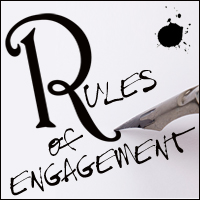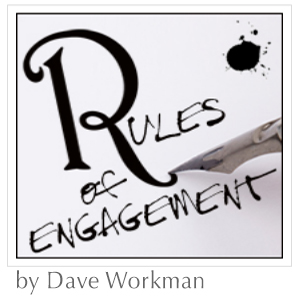.
 A blog for fiction writers and impending writers. An editor’s perspective.
A blog for fiction writers and impending writers. An editor’s perspective.
• Next post • Previous post • Index
Exciting, But Simple.
I’m not sure if there’s a sage in the world who can teach the secrets of exciting writing. If they can’t, I certainly can’t either.
Those same sages likely can’t define the various elements that ultimately define a truly thrilling novel. By exciting, I’m not speaking about a constant, continual barrage of chills and spills, page after page after page. Your intent is not to provide an unyielding roller-coaster rush, nor an incessant, thunder-and-lightning sort of excitement—but rather the finesse to transport readers to another realm and/or reveal the depths of an entirely fictive being. If successful, readers will stay with you until the final word of the last page. Exciting novels can be told in a whisper, can be written without the stench of death or the horror of mass destruction; without a single tear drop or belly laugh or even a boffo, surprisingly twisted last page that defies the reader’s expectation. Exciting novels simply must be told in exciting ways.
My idea of fictive excitement? It’s a combination of developing a witty and engaging style, an active—not passive—voice (see Active Voice and Show, Don’t Tell), and the ability to tell a complete story. Excitement is in the eye of the beholder, after all. And, in my opinion, excitement is simply a writer’s ability to prompt readers to, without hesitation, turn to the next page. And if I knew the secret formula every time I sat down to write, I’d own the New York Times Best Seller List.
I do not.
I do happen to believe that writers, like ball players, concert cellists and chess masters, are born into this world fully equipped with the ability to succeed. Some will never have the chance or the perseverance to fully explore or hone our true talents. Others will spill blood, sweat and tears, but never catch that lucky break. (Sorry, yeah, it’s about luck, too.) Sometimes, good writers simply encounter bad timing. Or the wrong agent, or editor, or the wrong publisher. And don’t think I haven’t lost a sleepless night or two fretting about that last quandary. I have.
And sometimes, the most diligent of souls, the sweetest of people, simply aren’t creative or technically skilled enough. Almost, but not quite. The world is filled with manuscripts, piled high in milk crates crammed into back corners of countless closets. As my old granny used to say, “You can’t make a Ferrari out of a Studebaker.”
She’s right. But the biggest tragedy is never knowing. Never trying. The world may indeed be overladen with Studebakers pretending to be Ferraris, but I suspect the world also has its fair share of idling Ferraris, glumly assuming they’re Studebakers. These are the writers who’ll never allow themselves the chance to experience themselves flying balls out down that literary speedway of life. And that’s a shame.
As hopeful authors, most of us are capable of crafting and honing our mechanical abilities—we can read creative writing books, we can study language and craft and attend workshops—we’re able to eventually intuit a noun from a verb. Because a writer can learn the simple stuff. But you can’t learn what can’t be taught. You can’t learn writing excitement.
So when I talk about excitement, I’m talking about a writer’s ability to create an individual style, that unique blend of panache and enthusiasm and articulation. Style can’t be bought or taught or handed down, generation to generation. Nobody taught Picasso Cubism. Nobody taught Babe Ruth to hit homers. Nobody taught Einstein to think. They each had it in ’em, all along.
If you have it—and Tom Wolff would call it the right stuff—good for you. Aim for the center field bleachers. If you don’t have it, you’ll discover that soon enough and move on. Ninety-five percent of wannabe fiction writers move on, and often to even greater endeavors. Ain’t no shame in crossing off write a novel from your bucket list, before skiing the Alps or designing a home or discovering cold fusion.
So… do I have advice for those of you attempting to determine your own stylistic prowess? (Does a goose have paté?) I can offer a few suggestions to flint that spark, to perhaps ignite something inside that might never extinguish.
Suggestion #1. New to fiction writing? Overwhelmed by the concept of writing 300 or 400 pages end-to-end? Unsure of your own abilities or talent or stamina? Start with smaller bites. Write a short story. Write an idea. Write a slice of life—a simple scene, a simple page with no beginning or no end—with no other agenda than pure enjoyment. Write for yourself. Make yourself smile. If that works… write another page. If you find yourself pouring out your soul, or simply amusing yourself with your own creative genius, perhaps you’re onto something. But writing a novel is kinda like giving birth. Give it time. Give it room. If you start pushing too hard at three months you’ll only hurt yourself, and the kid’ll be thinking WTF, mom?
Suggestion #2. Chances are, if you’re a writer, you’re also a reader. As a reader, what excites you? When I write, I keep a favorite novel on my desk and, most mornings before I begin working, I pick a random page and begin to read. Sometimes I read a few paragraphs, sometimes a few pages. I read until I’m filled with awe and appreciation and amazement that, yeah, that’s great stuff. And I can do it too.
By reading snippets, I’m not suggestion that you emulate a writer’s style or content—my attempt isn’t to plagiarize substance or verbiage—I’m simply trying to jump start my own creative juices by absorbing another writer’s creative juices. It’s the literary equivalent of a Vulcan Mind-Meld.
Suggestion #3. Concentrate on dialogue. If not on quantity, then on quality. The eyes may be the portal to the soul (as the poets like to say), but in fiction, dialogue is the portal to a character’s soul. (See Dialogue.) I personally believe dialogue to be the single most important asset to a unique voice. Try writing a few pages of dialogue; two people simply talking to each other. No other modifiers (i.e.; he said sweetly, or she chuckled insanely.) Simply two voices. Don’t think about it—just begin a dialogue. You might be amazed at how spontaneous (again, as in don’t think about it) you’ll find a situation (no matter how irrelevant) developing. For instance (and with zero contemplation) here’s my brain’s random output:
“Nada.”
“Haven’t seen you in a while.”
“Been busy.”
“Is that your elephant?”
“Nah. My mom’s.”
“He’s big, huh? What’s his name?”
“Buster.”
“Buster?”
“He don’t come when you call him, though.”
“No, I don’t think he’d give a shit.”
“Unless maybe you have ice cream.”
“Peanut butter?”
“Strawberry.”
“Man, you’d think peanut butter, huh?”
“Seriously, yeah. But Buster’s always been his own pachyderm.
Random, unrehearsed, out-of-nowhere stuff.
Why dialogue, you ask? Why spit out words without deliberation or expectation? Because you’re removing all mental parameters and preconceived notions about your writing. Fictional dialogue (like IRL dialogue) can be as ethereal, as eccentric, as quirky as your brain is willing to stretch. You’re disrupting the organizational structure of a few trillion synapses by crayoning outside the lines.
Will this sort of nonsensical (or at least unprepared) dialogue translate into a story? Maybe. Probably not. But do realize that you’re channeling your inner self here. You’re allowing yourself, if only for a moment, unfettered creative freedom—and mental exercises such as this may lead to a little personal insight about your own creative abilities. Creativity begets creativity after all.
Again, refer to Rule #3: Write to please yourself. If you find yourself writing for the various expectations of a vast and often fickle audience audience, you’ll eventually lose yourself in the crowd. Even if you’re successful, sooner or later you’ll maybe even sell your soul. So read a ton, learn the craft, study the mechanics of writing—and then write whatever makes you happy.
.
• Next post • Previous post • Index
.
.
